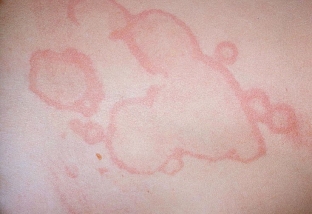Pathological processes that occur in the human body very often make themselves felt by the appearance of characteristic symptoms on the skin. Inflammatory elements, redness and swelling, as well as many other changes may indicate the presence of certain diseases. The appearance of annular erythema on the skin is also an alarming bell for the patient, signaling a threat. In today's article on estet-portal.com, find out what the appearance of erythema annulare on the skin indicates, and what its features will help to establish the correct diagnosis.
Annular erythema as a sign of a pathological process
The appearance of red spots on the skin – this is a fairly common occurrence that every person encounters. Redness of the skin can accompany many physiological processes, but in some cases it signals a pathology.
Erythema – this is an abnormal reddening of the skin associated with the expansion of blood vessels and stagnation of blood in them.
Erythema annulare is so called because it is characterized by the appearance of red rings with raised edges on the skin, limiting areas of unchanged skin. Such annular red spots are not an independent disease, but signal a pathological process, the cause of which needs to be clarified.
Erythema annulare:
- main causes of erythema annulare on the skin;
- pathogenetic mechanisms of development of erythema annulare;
- specific features of erythema annulare in various diseases.
The main causes of erythema annulare on the skin
The appearance of annular erythema on the skin can be a sign of pathological processes occurring in almost any structure of the body. Among the main causes of erythema annulare are:
- allergic reactions;
- rheumatic and other autoimmune diseases;
- fungal infections;
- hormonal disorders;
- helminthic infestations;
- pathologies of the immune system;
- intoxication of various origins;
- malignant neoplasms;
- Lyme disease;
- tuberculosis;
- chronic local foci of the infectious process;
- pathology of the gastrointestinal tract.
The appearance of erythema annulare can signal any of these pathological processes, so the correct diagnosis must be clarified.

Pathogenetic mechanisms for the development of erythema annulare
The pathogenesis of erythema annulare is quite simple, but understanding it is very important for specialists. The appearance of red rings on the skin is associated with a pathological reaction of the vessels. It is known that, under the influence of certain factors, depending on the underlying disease, the capillaries located in the skin & nbsp; expand, blood flow slows down in them and fluid pressure in the lumen increases. This leads to the fact that part of the plasma goes into the surrounding tissues and forms local edema – this explains the raised margins of erythema annulare. In addition to the liquid, T-lymphocytes also enter the tissues, confirming the close relationship between the pathology and the functioning of the immune system.
Features of erythema annulare in various diseases
Erythema annulare initially appears as a rounded red patch slightly raised above the skin surface. When pressed, this spot turns pale or even completely disappears. Gradually, a focus of enlightenment forms in the center of the erythematous spot, the skin becomes pink, then acquires a normal color. Depending on which features of erythema are observed in each individual case, one or another disease can be suspected:
- in rheumatism, the borders of erythematous rings are fuzzy, pale pink in color, can be located on any part of the skin, but more often on the shoulders and trunk. In addition to erythema annulare, symptoms such as muscle and joint pain, limited mobility, fever & nbsp; body over 38°C, heart failure;
- erythema annulare in Lyme disease is characterized by the presence of a rounded hemorrhagic crust or erosion in the center of redness – this is the site of the tick bite. Symptoms of intoxication are also characteristic: weakness, fever, muscle aches, and others;
- annular erythema of an allergic nature often bright, swelling is very pronounced, skin itching is characteristic. Erythema may be associated with rash like urticaria, angioedema, rhinitis or conjunctivitis.
Appearance of erythema annulare on the skin – this is a serious symptom that must be paid attention to.
A correctly collected anamnesis, a careful examination of the patient and carrying out the necessary additional studies will help establish the correct diagnosis and eliminate the pathology. estet-portal.com thanks you for your attention.
See also: "Erythema nodosum: why diagnosing the underlying disease is important".







Add a comment